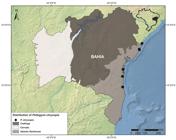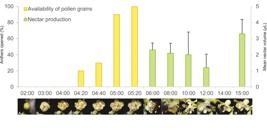ABSTRACT
Peltogyne chrysopis is an arboreal legume endemic to the Atlantic Forest and known only from the state of Bahia, Brazil. Focal observations were made of anthesis, pollen availability, stigma receptivity, nectar production, and the presence of osmophores and UV-reflective pigments for the species. Floral visitors were also observed and classified based on the timing and frequency of their visits and their foraging behavior. The breeding system was inferred from the pollen-ovule ratio and pollen tube growth after pollination treatments. Peltogyne chrysopis was found to be melittophilous, with anthesis occurring from 02h00min to 05h00min, and protogynous and xenogamous, with flower scent emission and pollen release before sunrise. Xenochlora nigrofemorata was the main pollinator, as it effectively collected and transferred pollen grains. Nectar production appears to be a secondary resource to ensure the attraction of a diversity of floral visitors and potential pollinators in the absence of effective pollinators. The results of the present study contribute to understanding the pollination mechanisms of Peltogyne, a genus that has been neglected with regard to its reproductive mechanism, and documents, for the first time, the role of the bee genus Xenochlora in plant pollination.
Keywords:
anthesis; compatibility system; floral rewards; Leguminosae; melittophily; pollinator efficiency; Xenochlora nigrofemorata

 Thumbnail
Thumbnail
 Thumbnail
Thumbnail
 Thumbnail
Thumbnail


